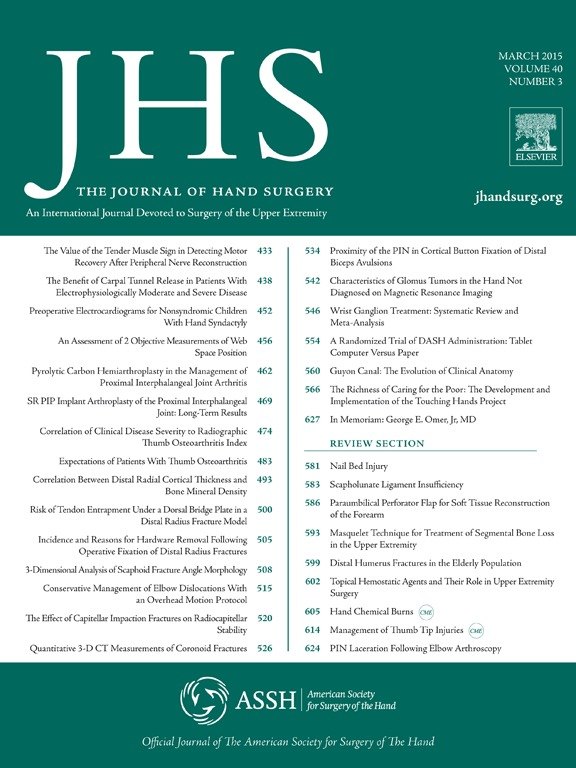
Lucerne cast provides no additional benefit for extra-articular fractures of the phalanges

Lucerne cast provides no additional benefit for extra-articular fractures of the phalanges
Extra-Articular Fractures of the Proximal Phalanges of the Fingers: A Comparison of 2 Methods of Functional, Conservative Treatment
J Hand Surg Am. 2012 May;37(5):889-98. Epub 2012 Apr 5Did you know you're eligible to earn 0.5 CME credits for reading this report? Click Here
Synopsis
66 patients with extra-articular fractures of the proximal phalanges were randomized to receive either a forearm cast or a Lucerne cast. Radiographic outcomes demonstrated that there were no significant differences between the two groups, in regards to palmar apex angulation and radial or ulnar angulation. However, once the cast was removed, range of motion was found to be superior in individuals with the Lucerne cast. This significant difference in range of motion was not seen at 12 week follow-up.
Was the allocation sequence adequately generated?
Was allocation adequately concealed?
Blinding Treatment Providers: Was knowledge of the allocated interventions adequately prevented?
Blinding Outcome Assessors: Was knowledge of the allocated interventions adequately prevented?
Blinding Patients: Was knowledge of the allocated interventions adequately prevented?
Was loss to follow-up (missing outcome data) infrequent?
Are reports of the study free of suggestion of selective outcome reporting?
Were outcomes objective, patient-important and assessed in a manner to limit bias (ie. duplicate assessors, Independent assessors)?
Was the sample size sufficiently large to assure a balance of prognosis and sufficiently large number of outcome events?
Was investigator expertise/experience with both treatment and control techniques likely the same (ie.were criteria for surgeon participation/expertise provided)?
Yes = 1
Uncertain = 0.5
Not Relevant = 0
No = 0
The Reporting Criteria Assessment evaluates the transparency with which authors report the methodological and trial characteristics of the trial within the publication. The assessment is divided into five categories which are presented below.
2/4
Randomization
2/4
Outcome Measurements
4/4
Inclusion / Exclusion
4/4
Therapy Description
4/4
Statistics
Detsky AS, Naylor CD, O'Rourke K, McGeer AJ, L'Abbé KA. J Clin Epidemiol. 1992;45:255-65
The Fragility Index is a tool that aids in the interpretation of significant findings, providing a measure of strength for a result. The Fragility Index represents the number of consecutive events that need to be added to a dichotomous outcome to make the finding no longer significant. A small number represents a weaker finding and a large number represents a stronger finding.
Why was this study needed now?
Extra-articular fractures of the proximal phalanges can be treated through a wide variety of conservative methods, which include different types of splints and castings. Currently, many of the treatment options include immobilization of the joints; however, the Lucerne cast allows for free mobilization of the wrist joint. Regardless, the main goal of all strategies should be to restore optimal function. The aim of this randomized controlled trial was to compare the Lucerne cast with the traditional forearm cast in patients with fractures of the proximal phalanges at 12 week follow.
What was the principal research question?
Does the Lucerne cast lead to superior range and motion and restoration of function in comparison to a conventional forearm cast for the treatment of extra-articular fractures of the proximal phalanges in the adult population at 12 week follow-up?
What were the important findings?
- no significant differences in radial range of motion were observed between the two groups (p>0.05)
- wrist joint motion was significantly greater in the Lucerne group once the cast was removed (p<0.05); however, the difference was not seen at a 12 week follow-up
- no differences between the two groups were seen in radiological outcomes
What should I remember most?
Both clinical and radiological outcomes are similar when the Lucerne cast is compared to the conventional forearm cast at 12 week follow-up.
How will this affect the care of my patients?
Clinicians should still consider using the widely accepting casting methods for extra-articular fractures of the proximal phalanges.
Learn about our AI Driven
High Impact Search Feature
Our AI driven High Impact metric calculates the impact an article will have by considering both the publishing journal and the content of the article itself. Built using the latest advances in natural language processing, OE High Impact predicts an article’s future number of citations better than impact factor alone.
Continue



 LOGIN
LOGIN

Join the Conversation
Please Login or Join to leave comments.